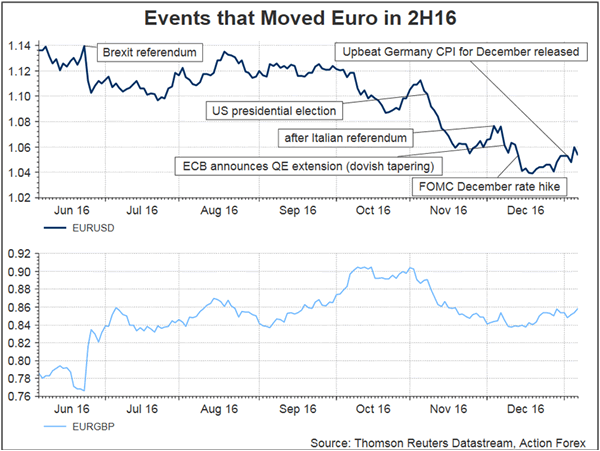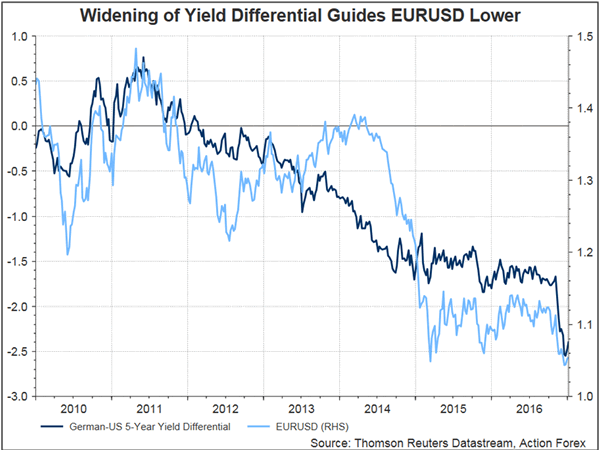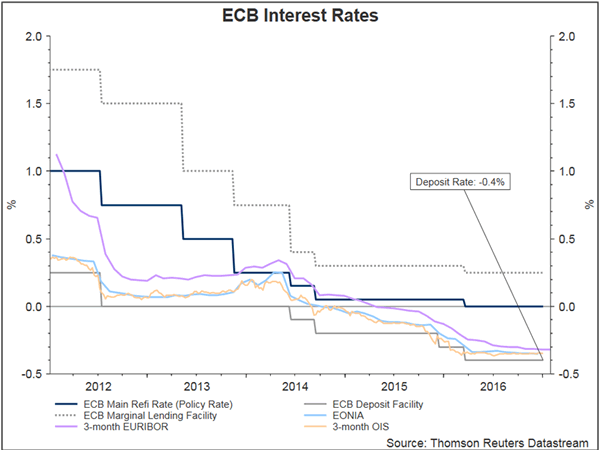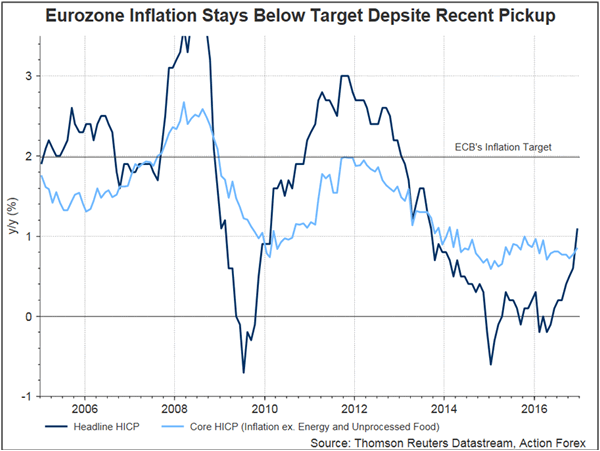Subdued economic growth and unconventional easing measures resulted in EURUSD’s third consecutive yearly decline, although the loss was greatly trimmed to about -3%, last year. EURGBP, however, jumped +16% as sterling slumped on concerns over British economic outlook after Brexit. Risk is to the downside for the single currency in 2017 as pressured by elevated political uncertainties and ECB’s dovish tapering stance. Recent upside surprises on inflation data would not make ECB less dovish. Core inflation remained weak and should only improve gradually this year, not sufficient for the central bank to commit to tapering. A break below the 1.0463 low in March 2015 has paved the way for EURUSD to go further lower. We expect EURUSD to reach parity by 2Q17, probably after French election.
Election Year Raises Political Risks: 2017 is an election year in Europe, marked by elections in France, Germany, the Netherlands, and possibly, Italy. Following a ‘yes’ vote in the Brexit referendum and a ‘no’ vote in the Italian referendum to reject the senate reform, the market has turned increasingly concerned that the rise of populist, anti-globalization sentiment would trigger another crisis in Europe. Such anxiety is not groundless. The key focus is on the French presidential elections in May. It is likely that Marine Le Pen from the far-right Front National party would become president. She pledged to hold a ‘Frexit’ referendum on French membership of the EU. As she suggested at a recent interview, France needs to’renegotiate with the EU because I want to see French sovereignty restored in France, supported by a referendum… I will announce that a referendum will be held in six months time. I will spend those six months going to the European Union and telling them: ‘I want the French people to regain at least their territorial sovereignty because I want to control the borders – they don’t belong to you’. Le Pen, however, suggested that France should keep euro even after ‘Frexit’.
Meanwhile, polls of the Netherlands’ general election, scheduled on March 15, suggested that the eurosceptic PVV party would get the biggest number of seats while falls short of a majority. Scheduled in September, Germany’s election might see the far-right, eurosceptic AfD party win as much as 15-20% of seats in the lower house. The centrist Grand Coalition would likely continue but with a shrunk majority. Italy has already fallen into political turmoil since Prime Minister Matteo Renzi’s defeat in the December constitutional referendum. The crisis is exacerbated by an electoral law known as’ Italicum’ which came into force in July. The law allows a party to form a majority single-party government if it wins a certain share of votes. If a party wins 40% of the popular vote, it will automatically be allocated 54% of the seats in the lower house. If no party achieves that benchmark, a second round would be held in which the two biggest parties participate. The winner of that second round would still get 54% of the seats in the lower house. The populist, eurosceptic Five Star Movement is running neck and neck in the opinion polls with Renzi’s Democratic Party. Last month’s referendum has, however, greatly increased the popularity of the former.
ECB’s Dovish Tapering
At its December meeting, ECB announced to extend the program until December 2017 but the pace of asset purchases would slow to 60B euro per month from April 2017, compared with the current 80B euro. President Mario Draghi indicated that the "calibrations" reflected the "moderate but firming recovery of the euro area economy" and the "subdued underlying inflationary pressures". He maintained a dovish tone, noting that the members still expected risks to Eurozone’s growth skewed to the downside. He affirmed that the new measures are not tapering and pledged that the program "goes until December 2017 or beyond, if necessary, and until we see a sustained rise in inflation". Draghi also noted that the move allows ECB to maintain a ‘sustained presence’ in the markets. In this sense, the reduction in pace of buying was way-out for ECB to continue QE amidst bond scarcity. Indeed, ECB made some change changes in the parameters of the QE with the ECB now allowed to buy government bonds which are yielding less than its deposit rate of -0.4%. Moreover, the securities lending program now accepts cash as collateral. A dovish ECB is in contrast with a more hawkish Fed which, as unveiled in the December minutes, sees accelerating pace of rate hike this year.
Inflation Picking Up?
Headline CPI in the Eurozone accelerated to +1.1% y/y in December, from +0.6% a month ago. Core CPI also picked up to +0.9% y/y from +0.8% in November. Energy inflation soared to +2.5% from -1.1%, whilst food, alcohol & tobacco inflation rose to +1.2% from +0.7%. Services inflation also climbed higher to +1.2% from +1.1%. In Germany, headline CPI more than doubled to +1.7% y/y in December. This came in better than expectation of a rise to +1.4%. Pleasant surprise in December inflation has once again brought about rhetoric of ECB rate hike from certain German officials. However, we not see improvement in inflation data a trigger for ECB’s tapering, let alone rate hike. Not only does headline CPI remain far below ECB’s target of’ close to, but below, +2%’, but core inflation also remains weak. Executive board member Benoît Cæuréat noted last month that the ECB is still awaiting ‘signs that core inflation is on the rise and will clearly exceed +1%’. December’s data shows that core CPI stayed below +1%. The underlying trend signals that it would only rise gradually this year and is expected to stay below +1% most of the year. Indeed, we see core inflation to undershoot ECB’s forecasts of +1.1% in 2017 (followed by +1.4% in 2018 and +1.7% in 2019), a scenario that might lead the ECB to extend QE purchases in 2018.


















